Today, I’m reviewing a book produced from a clever angle. It offers a unique way of examining crewelwork by combining the expertise of two well-known names in the world of embroidery, each of whom has a contrasting approach to the topic.
Newly published, Crewelwork Then & Now by Hazel Blomkamp and Phillipa Turnbull is a project book that offers the reader the opportunity to experience both traditional crewelwork and contemporary interpretations of crewelwork.
Let’s take a look at it…
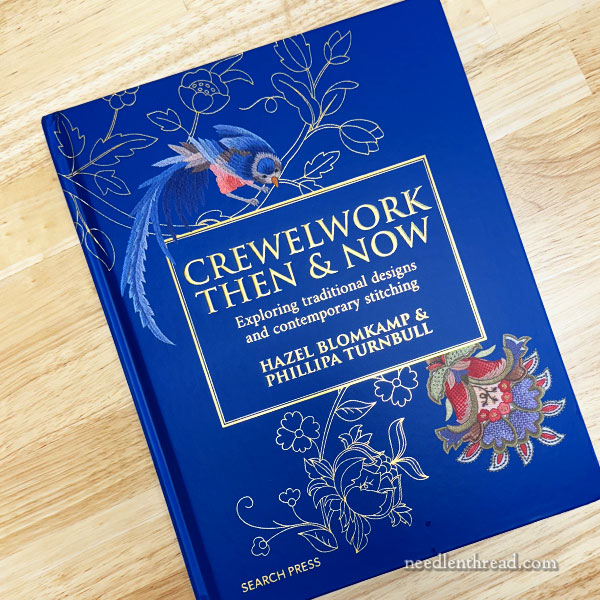
Crewelwork Then & Now: Exploring Traditional Designs and Contemporary Stitching is a lovely hard-covered book in a gorgeous blue and gold. The cover, I have to admit, immediately captured my attention. I am a sucker for nice-looking books!
The title could perhaps be a bit misleading, and admittedly, it rubbed me the wrong way at first. You really have to pay attention to the subtitle.
The “Then & Now” in the title does not imply that the crewelwork of the past and today’s interpretations of crewelwork in contemporary ways belong to two eras entirely distinct and distant from each other – as if the “then” is no longer relevant today and the “now” is the norm. If there were no subtitle, you could certainly take it that way.
However, the book is not meant to relegate the traditional approach to crewelwork to the distant past while making contemporary approaches of sole relevance today. Instead, it gives both their due place in the world of stitching.
The projects in the book represent two approaches:
One approach is traditional crewelwork in traditional and modern designs, worked with the materials and stitches that have been associated with crewelwork for centuries.
The other approach is a more exuberant interpretations of designs reminiscent of those used in crewelwork of yore, but adopting more modern materials, embellishments, colors, and a wider conglomeration of stitches and techniques to work the designs.

The authors are Philippa Turnbull of The Crewelwork Company in the UK, which is well-known for its focus on historical crewel embroidery, and Hazel Blomkamp of Hazel Blomkamp Fine Needlework in South Africa.
They each have their own approach to embroidery and design, and these are cleverly juxtaposed throughout the book.
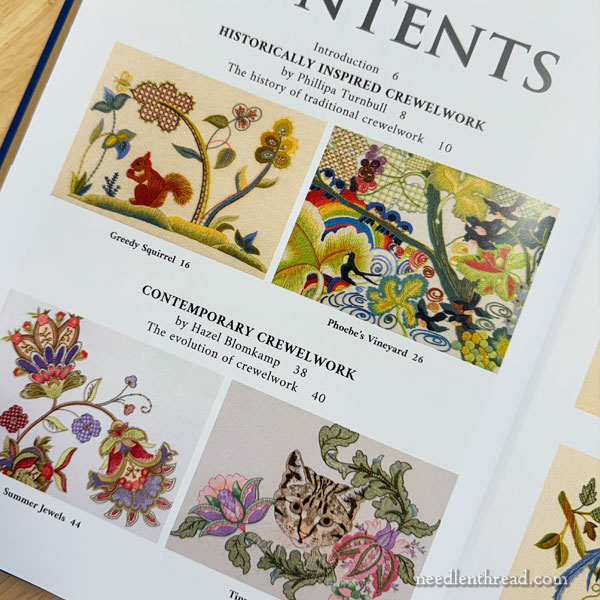
Philippa speaks to the history of traditional crewelwork in her introduction, while Hazel focuses on the evolution of crewelwork.
The book features four projects from each author, with eight projects total.
The first two projects from each are presented in their respective context: historical and contemporary.
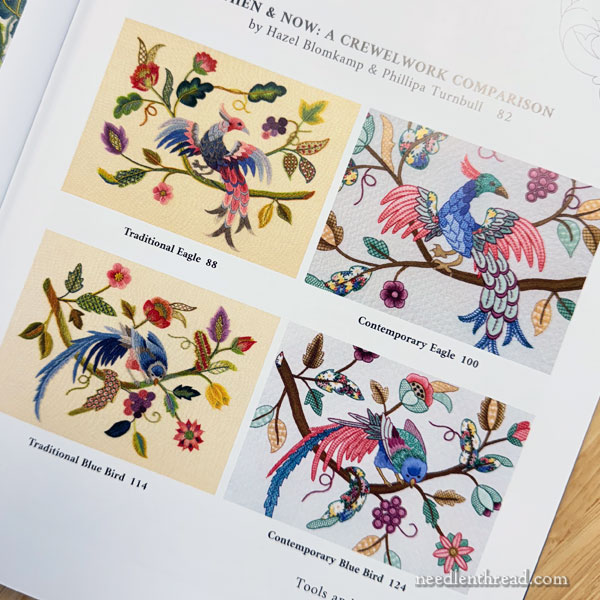
The second two projects from each are side-by-side comparison projects, where two designs are interpreted by each author according to her own approach, one using more traditional techniques and the other using more contemporary approaches.
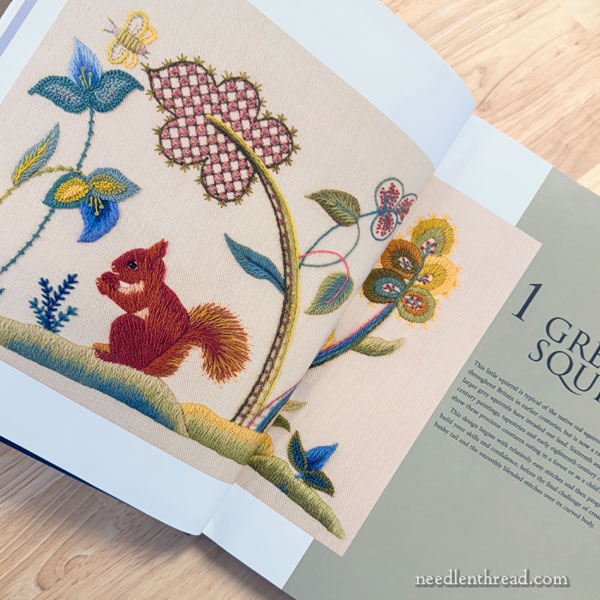
Each project is presented with an introduction and lovely large-scale photos.
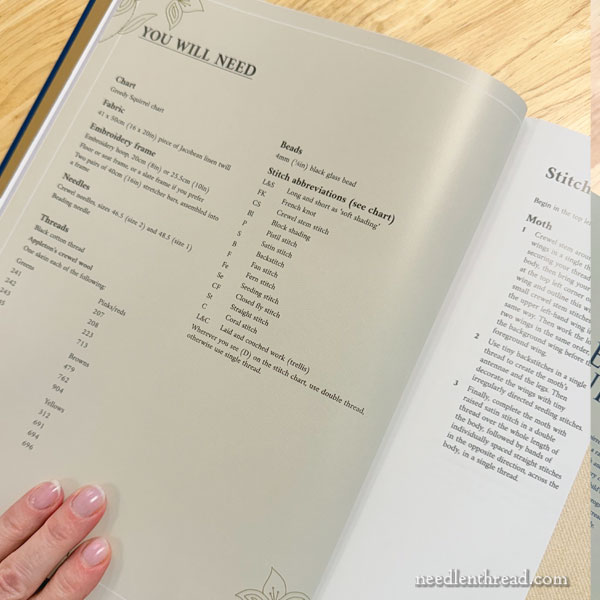
You’ll find a thorough materials list, followed by the stitching instructions.
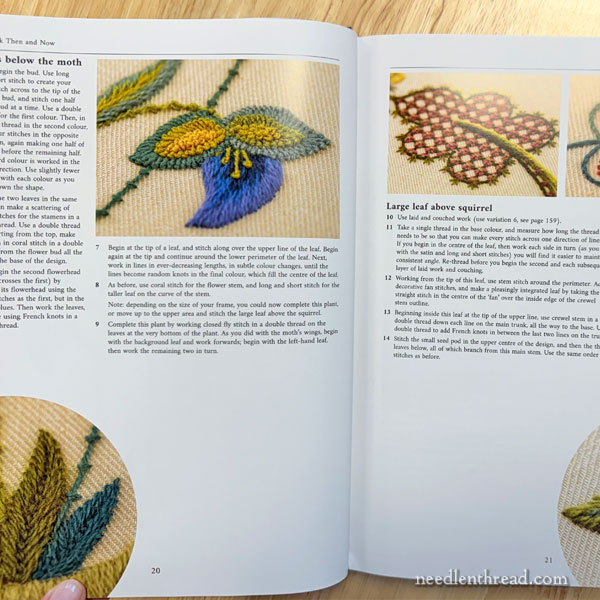
The instructions at this point are presented entirely through text, with photos of the finished embroidery for reference.
You can see a portion of this in the photo above. There are large images of finished elements in the design, with text explanation of how to go about stitching them.
While you don’t see step-by-step stitching progress in the instructions, there is a stitch dictionary in the back of the book (see below) with instructions and diagrams for working the stitches involved.

The photos are quite large and clear, so that you can use them for reference. You can see very easily what you’re meant to achieve by following the written instructions.

Hazel’s contemporary interpretations take traditional crewelwork motifs and stitch them up in fantastic ways, incorporating a fabulous array of color, stitches, and texture.

This “Summer Jewels” project features an exuberant display of fillings, colors, textured stitches, and embroidery with beads. While the motifs you see here are associated with Jacobean designs often used with traditional crewelwork, the interpretation is a much more contemporary.
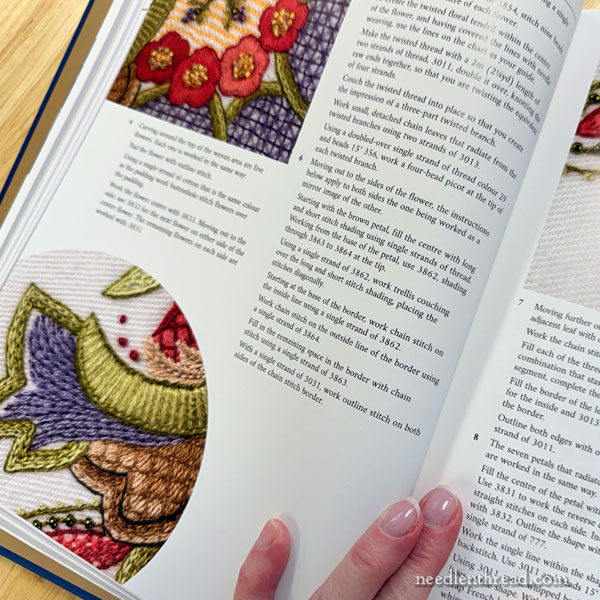
The project approach is the same: a materials list followed by written stitching instructions that are accompanied by large, clear photos of the finished embroidered element.

For cat lovers, there’s Tiny The Tabby, too! The incorporation of animals in the contemporary designs perhaps reflects the traditional incorporation of animals in many crewel designs (like the squirrel already mentioned above), but the presentation and framing of the animals is decidedly different.
I’ll mention Tiny The Tabby again below, to put design size in perspective.

The juxtaposed designs of “then” and “now” interpretations are quite interesting. Each has its appeal, depending on the style of embroidery you’re after.
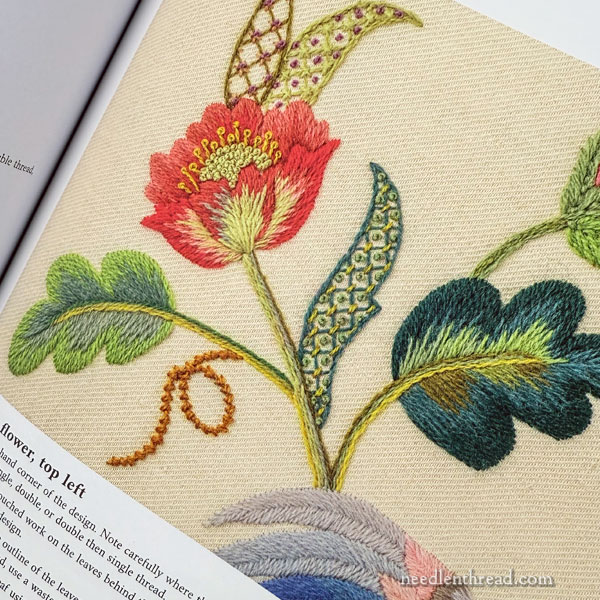
Philippa leaves.
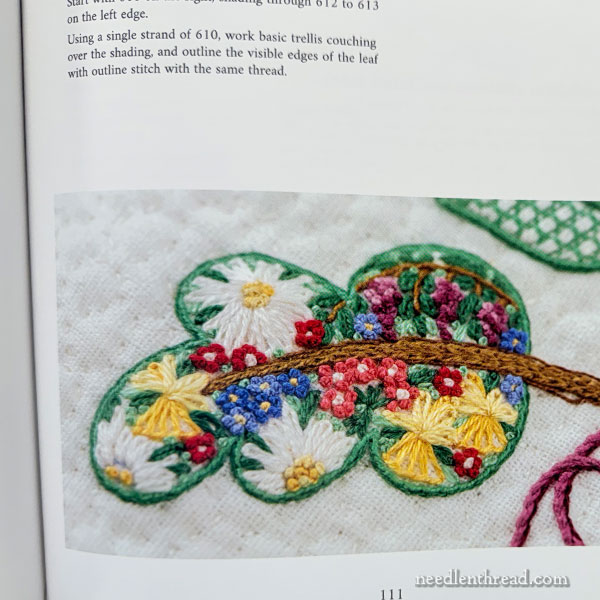
Hazel leaf.
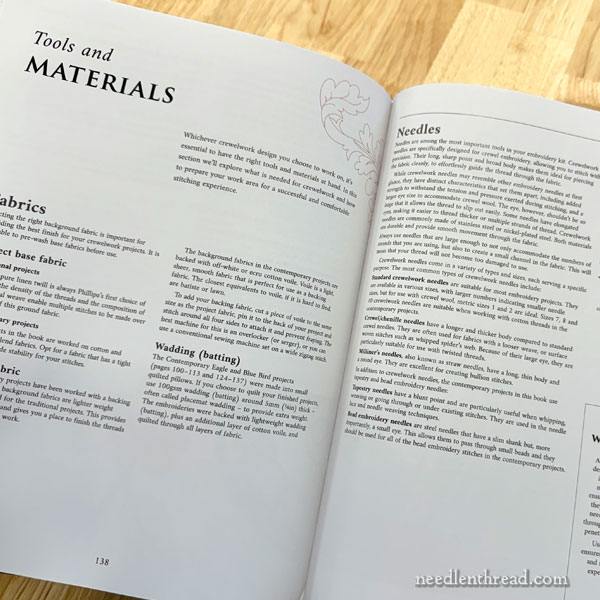
When you move towards the back of the book, past the projects, that’s where you find all the preliminary information for getting started with the embroidery – general information on materials and supplies, tools, transfer and set-up, and so forth.
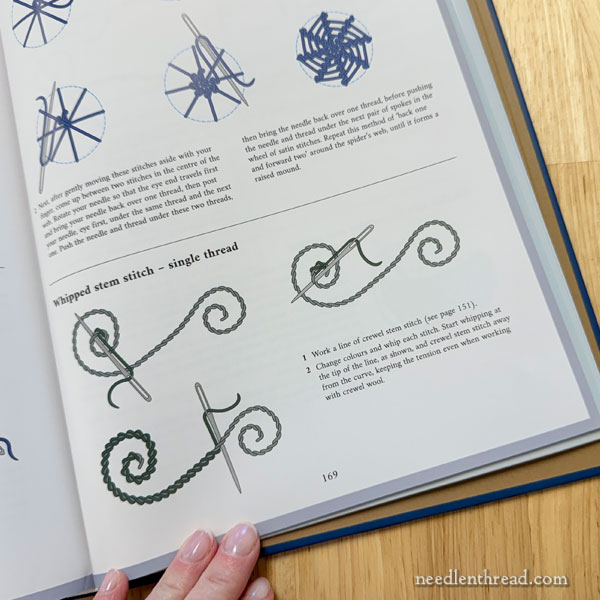
This is also where you find the technique and stitch instructions, which are all presented as diagrams with text explanation, as shown above. If you have any of Hazel’s books, you’ll be familiar with this presentation.

Attached to the back inside cover of the book, you’ll find an envelope of full-size charts, which are your design resource (you trace the design from the chart). They also provide you with other information, too.

When you open up the charts, you’ll likely notice that these are not “small” projects. In the photo above, the entire open book is well covered by the chart, which takes up much of the end of my work table.
You can also see that there are numbers, letters, and sometimes words on the different design elements. Depending on the chart, the information on the design elements indicate threads, colors, and / or stitches.
You’ll find an explanation of how to use the design charts at the beginning of each project section.
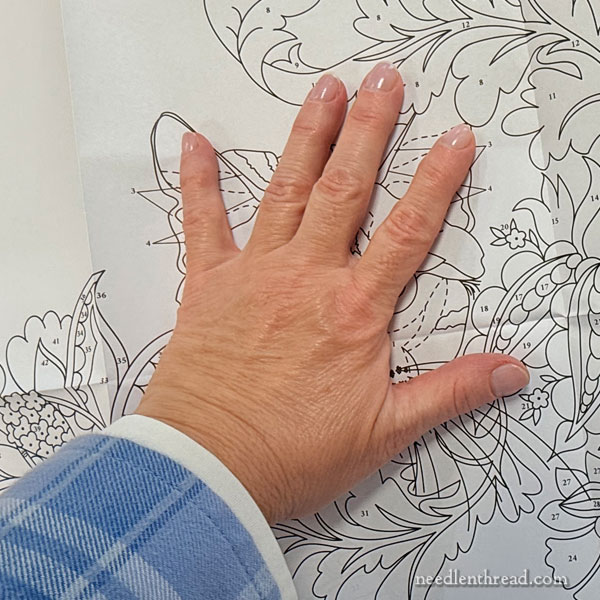
“Tiny The Tabby,” whose head extends beyond my hand there, isn’t quite as small as his tiny wee name implies!
In a Nutshell
Crewelwork Then & Now would be a nice addition to the library of any stitcher who appreciates traditional crewel embroidery and loves contemporary interpretations of traditional design. It’s a fun book, with an interesting angle.
The book is not heavy on step-by-step instruction. It assumes that the reader has some experience following stitch diagrams and following written instruction.
The illustrations throughout the book are an excellent guide to help the stitcher achieve expected outcomes. You can see very clearly how your stitching is meant to turn out.
For the vast array of stitches and techniques in the book, you can’t go wrong with this one!
Where to Find It
Crewelwork Then & Now is available on Amazon. I’ve listed it right here on my Needlework Book Recommendation page.
I use an affiliate link for my Needlework Book Recommendations page, which means that Needle ‘n Thread may receive a small commission on any purchases made through that link, with no extra cost to you. Thanks!



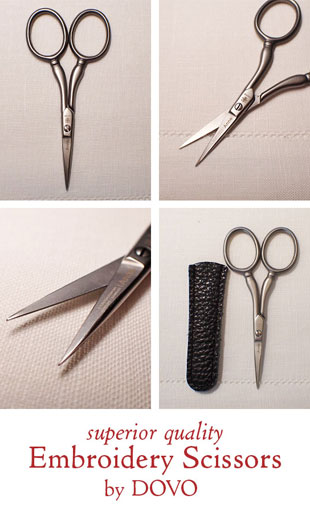




Leave A Comment